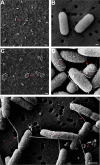Rapid effects of a protective O-polysaccharide-specific monoclonal IgA on Vibrio cholerae agglutination, motility, and surface morphology
- PMID: 25667263
- PMCID: PMC4363435
- DOI: 10.1128/IAI.02856-14
Rapid effects of a protective O-polysaccharide-specific monoclonal IgA on Vibrio cholerae agglutination, motility, and surface morphology
Abstract
2D6 is a dimeric monoclonal immunoglobulin A (IgA) specific for the nonreducing terminal residue of Ogawa O-polysaccharide (OPS) of Vibrio cholerae. It was previously demonstrated that 2D6 IgA is sufficient to passively protect suckling mice from oral challenge with virulent V. cholerae O395. In this study, we sought to define the mechanism by which 2D6 IgA antibody protects the intestinal epithelium from V. cholerae infection. In a mouse ligated-ileal-loop assay, 2D6 IgA promoted V. cholerae agglutination in the intestinal lumen and limited the ability of the bacteria to associate with the epithelium, particularly within the crypt regions. In vitro fluorescence digital video microscopy analysis of antibody-treated V. cholerae in liquid medium revealed that 2D6 IgA not only induced the rapid (5- to 10-min) onset of agglutination but was an equally potent inhibitor of bacterial motility. Scanning electron microscopy showed that 2D6 IgA promoted flagellum-flagellum cross-linking, as well as flagellar entanglement with bacterial bodies, suggesting that motility arrest may be a consequence of flagellar tethering. However, monovalent 2D6 Fab fragments also inhibited V. cholerae motility, demonstrating that antibody-mediated agglutination and motility arrest are separate phenomena. While 2D6 IgA is neither bactericidal nor bacteriostatic, exposure of V. cholerae to 2D6 IgA (or Fab fragments) resulted in a 5-fold increase in surface-associated blebs, as well an onset of a wrinkled surface morphotype. We propose that the protective immunity conferred by 2D6 IgA is the result of multifactorial effects on V. cholerae, including agglutination, motility arrest, and possibly outer membrane stress.
Copyright © 2015, American Society for Microbiology. All Rights Reserved.
Figures





References
-
- Liu L, Johnson HL, Cousens S, Perin J, Scott S, Lawn JE, Rudan I, Campbell H, Cibulskis R, Li M, Mathers C, Black RE, Child Health Epidemiology Reference Group of WHO and UNICEF . 2012. Global, regional, and national causes of child mortality: an updated systematic analysis for 2010 with time trends since 2000. Lancet 379:2151–2161. doi:10.1016/S0140-6736(12)60560-1. - DOI - PubMed
Publication types
MeSH terms
Substances
Grants and funding
LinkOut - more resources
Full Text Sources
Other Literature Sources
Medical
Miscellaneous

